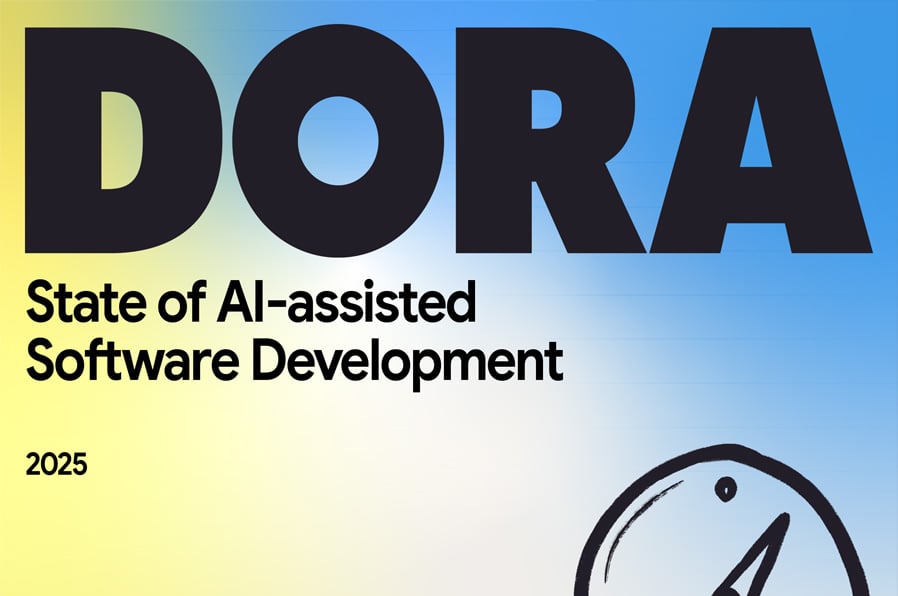Platform engineering SDLC
New DORA report: AI is an amplifier, is your organisation ready?

"Traditional Software Delivery is being disrupted by AI." A safe statement to make, but how can we safely tap its potential and boost overall Software Delivery performance?
In previous years, the DORA “Accelerate State of DevOps”-research project has consistently confirmed that:
- high performance software delivery is strongly correlated with high business performance (“IT is an asset, not a cost center”)
- speed and stability go together (“high performers get both, low performers neither”)
However, given the “once every decade”-kind of disruption (Gen)AI is currently demonstrating, the recently published “State of AI-assisted Software Development 2025” -edition has shifted focus significantly to uncover how AI can be leveraged in its fullest potential to boost software delivery in the enterprise.
At AE, the DORA research forms a cornerstone for our vision on SDLC, DevOps, and Platform Engineering. Given the findings in this latest report, it is clear that Software Delivery is entering a new phase. Software Delivery requires a holistic approach with proper governance over AI adoption based on Platform engineering and Value Stream Management. These are crucial pillars in achieving resilience and business impact in a scalable manner.
Let’s explore some of the findings.
Glance over the report
AI is the new normal
According to DORA, the adoption of AI in software development has become mainstream, with nine out of ten professionals now using AI tools in their daily work.
Respondents are getting more experienced, spend more time interacting with AI (2h per day), are becoming more reliant on AI tools (+70% moderate-to-high), for an increasing number of tasks (writing code, literature reviews, creating images, writing documentation, writing test cases, …).
AI is an amplifier
Individual developers report gains in productivity and code quality, but the overall software delivery is challenged:
- AI adoption correlates with reduced delivery stability
- AI does not automatically solve the human and cultural aspects of software delivery: friction and burnout are unaffected by AI use.

In short, AI acts as an amplifier where robust practices and healthy cultures exist, AI strengthens them. Where weaknesses persist, AI magnifies instability. So how can organisations adopt AI in a way that leverages this amplification-effect to their advantage?
Platforms and value streams: the foundations of successful AI adoption
While AI adoption is widespread and impactful, its benefits are not automatic. High-quality internal platforms and mature value stream practices turn AI into a sustainable driver of performance.
First, platform engineering (enabling developers with ‘golden paths’ and providing an optimal developer experience throughout the SDLC) is described as a true “force multiplier”. High-quality platforms amplify the effect of AI adoption, improving organizational performance, productivity and team well-being.
This is not just theory — our collaboration with Jan De Nul demonstrates how “golden paths” and a well-governed developer platform can accelerate delivery, improve developer experience, and lay the groundwork for sustainable AI adoption.

Although 90% of organizations state they have a platform capability, over half acknowledge gaps in automation and user experience, underlining the importance of advancing platform engineering maturity.
E.g.: AI-driven increases in code output risk moving bottlenecks further downstream (code reviews, build agent queues, test execution, …). A “Platform as a Product” mindset should keep your organisation aware of the overall software delivery performance.
Second, value stream management (VSM) provides the system-level compass that ensures AI’s local productivity gains translate into business outcomes. By making the flow of work visible from idea to customer, VSM connects product management and platform engineering. It highlights bottlenecks and aligns investment to where it unlocks true value. Teams with mature VSM practices can channel AI-driven improvements into solving system-level problems, ensuring that individual speed or efficiency gains result in organisational success.
In summary, a tools-focused approach will produce only limited results. (“without a proper foundation AI creates localized pockets of productivity, often lost to downstream chaos") A systemic-approach, on the other hand, with platform engineering and value stream management practices at its core, is better equipped to provide the overall governance that is essential in an AI-driven Software Delivery lifecycle.
DORA research in depth
The original report offers a lot more insights, which we will explore in a future post. For now, to give already some indication, other takeaways include:
- The famous (5) ‘DORA metrics’ remain as strong indicators of software delivery performance (3 throughput metrics + 2 stability metrics) and as such are excellent candidate KPI’s in any transformation effort.
- The ‘low to elite performers’ classification has been replaced by ‘7 team archetypes’, each telling a deeper story about strengths and constraints.


- A simplified “Core AI capability model” that specifically identifies drivers of AI-adoption.

note 1: the former more elaborate DORA capabilities model identifies a larger set of proven practices in a more traditional software delivery-context. note 2: We can expect this new AI-specific capability model to steadily grow together with ongoing research. - The “socio-cognitive” impact - AI has not meaningfully impacted how developers experience their work lives. It’s important however to remain cautious and make sure they continue to find value in their work.
From insight to impact
The DORA 2025 report makes one thing clear: AI, platform engineering, and value stream management are the cornerstones of high-performance IT in the years ahead. Translating these insights into tangible improvements requires focus, governance, and the right foundations.
At AE, we help organisations turn DORA’s insights into measurable impact:
- run an AE SDLC assessment (inspired by DORA) to help you benchmark your software delivery lifecycle using proven metrics and practices and build an improvement roadmap to improve flow without compromising stability.
- our Platform Engineering practice delivers paved paths and guardrails on Microsoft Azure and Red Hat OpenShift and ultimately embeds AI into the SDLC to provide an optimal Developer Experience.
- a Value Stream Mapping Workshop with our experts will help you visualise, analyse, and improve the flow of work from idea to customer.
Hopefully, we acknowledge together the wide range of challenges lying ahead in order to realize effective AI-assisted Software Delivery. AE is eager and well equipped to guide you.








